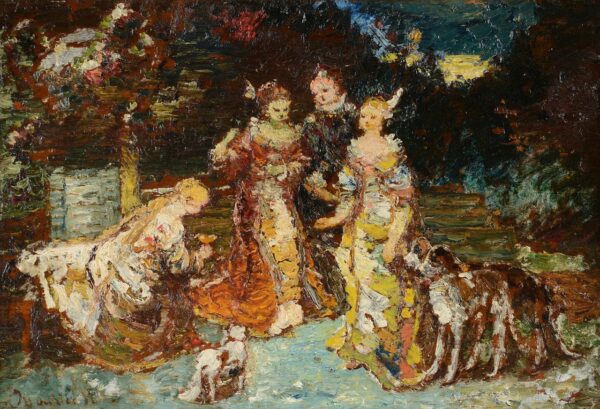“Quatre figures dans un parc”
Oil on panel: 34 x 50 cm
Signed (l.l.) ‘Monticelli’
"*" indicates required fields
Notes
Adolphe Joseph Thomas Monticelli, known as Adolphe Monticelli, was a French painter of the generation preceding the Impressionists. Monticelli was born in Marseilles.
Adolphe Monticelli at the age of eighteen attended the École Municipale de Dessin in Marseille from 1842 to 1846 and then left for Paris to continue his artistic training under Paul Delaroche at the École des Beaux-Arts. In Paris, Adolphe Monticelli made copies after the Old Masters in the Louvre, and the oil sketches of Eugène Delacroix.
In 1855 he met Narcisse Diaz, an artist of the Barbizon School, and the two two regularly painted together in the forest of Fontainebleau. Monticelli frequently adapted Diaz’s practice of introducing nudes or elegantly costumed figures into his landscapes.
Adolphe Monticelli developed a highly individual Romantic style of painting, in which richly colored, dappled, textured and glazed surfaces produce a scintillating effect. He painted courtly subjects inspired by Antoine Watteau, he also painted still life’s, portraits, and Orientalist subjects that owe much to the examples he studied of Delacroix’s oil paintings.
The young Paul Cézanne had befriended Adolphe Monticelli in the 1860s, and the influence of the older painter’s work can be seen in Cézanne’s work of that decade. After 1870, Adolphe Monticelli returned to Marseille, where he would live in poverty despite a prolific output, selling his paintings for small sums. He was an unworldly man, all he knew was his art. Between 1878 and 1884 Cézanne and Monticelli often painted landscapes together, once spending a month roaming the Aix en Provance countryside.
Confronted with criticism of his style of painting Adolphe Monticelli himself remarked, “I paint for thirty years from now”. In its painterly freedom, Monticelli’s work prefigures that of Vincent van Gogh, who greatly admired his work after seeing it in Paris when he arrived there in 1886. Van Gogh never met him because Monticelli died a few months before Van Gogh arrived in Paris. Van Gogh immediately changed to a brighter colored palette and heavier use of paint and brushstrokes.
Provenance
- Kunsthandel G.J. Nieuwenhuizen Segaar, Den Haag.
- Sotheby’s, Amsterdam, 1999, lot 245;
- Private collection, The Netherlands
- Douwes Fine Art, Amsterdam, 2022
Expertise
Certificate by Marc Stammegna, 6 february 2002.







